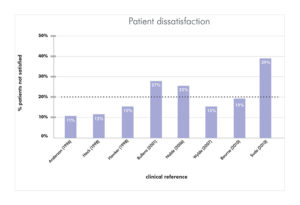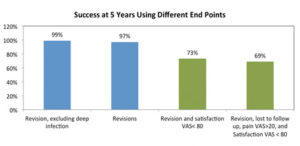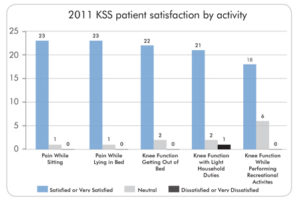A successful procedure and a satisfied patient are not the same
Today, over five million people are living with total knee replacements1. More and more, the clinical evidence is confirming that one in five of those patients is not satisfied with their results. 
Some of the leading causes of patient dissatisfaction include:
- Residual pain: Poor femoral component fit and improper rotation of the tibia result in a 1.9x3 and 5x4increase in the risk of residual pain, respectively
- Compromised function: 2-3 times as many patients with a TKR reported some degree of difficulty with everyday activities relative to an age-matched control group5
- Early implant failure

There Has to Be a Better Way
While knee replacement surgery is associated with very low revision rates, there has to be a better way to provide patients with a satisfactory solution to their knee pain.
A retrospective analysis of 89 iTotal patients (106 knees) found that 100% of patients reported a normal feeling knee only seven months after the procedure. In addition, in a subset of 24 patients, zero patients reported dissatisfaction in 4 out of 5 KSS categories at 7 months post-op.

1: Thornhill, et al; How Many Americans are Currently Living with Total Knee Replacements? Abstract from AAOS Annual Meeting: 2012
2: Bullens PHJ et. al.; Patient Satisfaction After Total Knee Arthroplasty: A Comparison Between Subjective and Objective Outcome Assessments; J Arthroplasty; 2001; Vol. 16; No. 6, pp. 740-747.
3: Mahoney, et al; Overhang of the Femoral Component in Total Knee Arthroplasty: Risk Factors and Clinical Consequences. The Journal of Bone and Joint Surgery; 2010, 92: 1115-1121
4: Barrack, et al; Component Malrotation and Anterior Knee Pain after Total Knee Arthroplasty. Clinical Orthopaedics and Related Research; 2001, 392: 46-55
5: Noble, et al; Does Total Knee Replacement Restore Normal Knee Function? Clinical Orthopaedics and Related Research; 2005, 431: 157-165
6: Kurtz, et al; Early Outcomes Utilizing a First-Generation Customized Patient-Specific TKA Implant. BASK Annual Meeting 2014, Poster #0185

